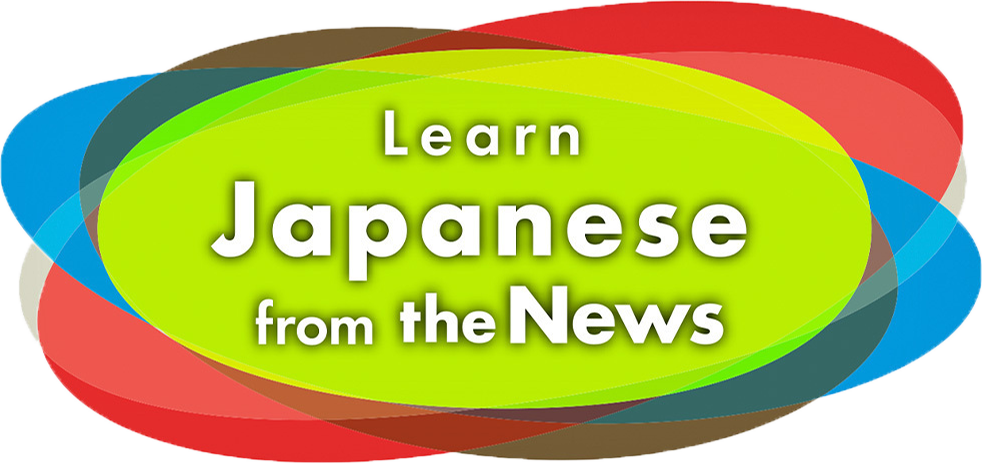
Learn Japanese from the News
Lessons on this site use content from the NHK WORLD JAPAN program "Learn Japanese from the News." Use the news to learn Japanese and take conversations to a new level.

Learn Japanese from the News
Lessons on this site use content from the NHK WORLD JAPAN program "Learn Japanese from the News." Use the news to learn Japanese and take conversations to a new level.
島根県の農家では、アイガモを田んぼに入れて、雑草や害虫を食べてもらうことで農薬を使わないで米を作っています。ニュースを通して「気持ちよさそうに」の「そう」について学びましょう。
しまねけんの のうかでは、 アイガモを たんぼに いれて、ざっそうや がいちゅうを たべてもらうことで のうやくを つかわないで こめを つくっています。 にゅーすを とおして 「きもちよさそうに」の 「そう」について まなびましょう。
Shimane-ken no nooka dewa, aigamo o tanbo ni irete, zassoo ya gaichuu o tabetemorau koto de nooyaku o tsukawanai de kome o tsukutteimasu. Nyuusu o tooshite 「kimochi yosasoo ni」 no 「soo」 ni tsuite manabimashoo.
Today’s news story is about a farmer in Shimane Prefecture who grows rice without using any agricultural chemicals by releasing ducks into his rice paddies. The ducks eat the unwanted weeds and pests. Follow along to learn expressions that use 「そう」, like 「気持ちよさそうに」.
島根県飯南町の農家の宇山智明さんは、薬を使わないで米を作っています。
Play

English
Uyama Chiaki, a farmer in the town of Iinan in Shimane Prefecture, grows rice without using chemicals.
![]()
薬を使わないと、米を作るのに邪魔な草や虫が増えます。
Play

English
When you don’t use chemicals, you get more weeds and pests that interfere with rice production.
Explanation
In this context the word 「くすり(kusuri)」refers to agrichemicals.
Releasing ducks into paddy fields as an alternative to using chemicals is called the Aigamo method.
![]()
このため、アイガモという鳥を田んぼに入れて、草などを食べてもらいます。
Play

English
For this reason, he releases what are called aigamo ducks into his rice paddies and has them eat the weeds and pests.
![]()
今年は5月14日、この鳥の赤ちゃん100羽を田んぼに入れました。
Play

English
This year, on May 14, he released 100 aigamo ducklings into his rice paddies.
![]()
集まった20人ぐらいがみんなで入れました。
Play

English
About 20 people gathered to help him release them into the rice paddies.
![]()
鳥たちは田んぼの中を気持ちよさそうに泳いで、ときどき草などを食べていました。
Play

English
The ducklings seemed to be enjoying a pleasant swim on the paddies, and could occasionally be seen eating weeds and other things.
Explanation
The phrase 「気持ちよさそうに(kimochi yosasoo ni)」 combines the adjective 「気持ちいい(kimochi ii)」 with 「そう(soo)」.
Of course, we have no idea how the ducks are actually feeling. But this is a phrase we use when we speculate based on visual cues.
When adding 「そう」 to the adjective 「いい(ii)」, we change 「いい」 to 「よさ」, and it becomes 「よさそう」. So 「気持ちいい」 becomes 「気持ちよさそう」.
![]()
田んぼでは、9月に米ができて稲を刈る予定です。
Play

English
The rice paddies will be ready for harvesting in September.
![]()
farmer
農家
のうか
nooka
paddy field/rice field
田んぼ
たんぼ
tanbo
rice plant
稲
いね
ine
![]()
Shuffle
日
Japanese
E
English


ロン(Long)
最近日本の会社で働き始めた。ソフィアの後輩。
アン、一恵と同じマンションの住人。

ソフィア(Sophia)
ロンと同じ会社で働く先輩。子育てをしながら、日本で5年間働いている。

田中健司
ロンの上司。中学生と、小学生の2人の子どもがいる。

アン(An)
夫が日本で働くことになり、一緒に日本で暮らしている。小学生の娘がいる。

鈴木一恵
ロン、アンと同じマンションの住人。現在は一人暮らし。
At a restaurant, Sophia and her friend are discussing the pro and cons about the price change in rice when it is grown without the usage of agricultural chemicals.

ソフィア:(レストランのスタッフへ)私は「鴨肉のソテー」、こちらは「ビーフシチュー」ね。
Play
Show

English
(to the waiter) I’ll have the 「鴨肉のソテー」 and she will have the 「ビーフシチュー」.
![]()

友だち:そうそう、鴨と言えば、アイガモを使った米作りって知ってる?
Play
Show

English
Oh, by the way, speaking of ducks, do you know about the method of growing rice using ducks?
Explanation
「そうそう、●●●と言えば、(Soosoo, ●●● to ieba,)」:We use the phrase 「そうそう」 and 「そう言えば」 when we want to bring up a new topic. Here, Sophia’s friend is bringing up a new but related topic, so she uses the expression 「●●●と言えば、」 at the beginning of her sentence. It is a useful way to steer the conversation in the direction that you want.
![]()

ソフィア:ああ、農薬を使わない「アイガモ農法」ね。
Play
Show

English
Oh, you’re talking about the “Aigamo method,” where you don’t use any agricultural chemicals.
![]()

友だち:でも、アイガモのエサ代とかかかるし、費用対効果はどうなのかな。
Play
Show

English
But it costs money to feed the ducks and so on. I wonder how cost-effective it is.
Explanation
「費用対効果(hiyoo-tai-kooka)」 in English is “cost-effectiveness,” “price-performance ratio,” or “cost-performance.” Some people say 「コスパ」, the shortened version of “cost-performance.” It refers to the balance between the time and cost spent and how much profit was made.
![]()

ソフィア:わたしは値段が高くても農薬を使っていないお米を買いたいなぁ。
Play
Show

English
I would buy rice grown without agricultural chemicals even if it was expensive.
![]()

友だち:そうぉ? うちは家族が多くてお米をたくさん買うからねえ。
Play
Show

English
Really? I have a big family, so I have to buy a lot of rice.
Explanation
「そうぉ?(Soo o?)」 is used to express doubt about what the other person has said. The voice rises a little bit at the end of the 「お」. This expression is followed by an opposite opinion or by a phrase that is neither for nor against the other person’s opinion but allows the person to keep middle ground until they make up their mind.
![]()

ソフィア:でも、わたしたちみたいにいろいろな考えの人がいるから、農家もいろいろな工夫をするのかもしれないね。
Play
Show

English
I guess farmers become more creative with their methods because there are people with differing opinions, like us.
![]()
![]()
![]()
Play All
![]()
Show All
![]()
Reset